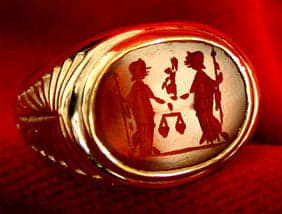Roman Carnelian Intaglio Depicting Two Goddesses, 100 CE - 300 CE
Carnelian-Gold
FJ.6838
Further images
This Genuine Ancient Seal Has Been Set in a Modern 18 Karat White Gold Rin The art of glyptics, or carving images on colored precious stones, is probably one of...
This Genuine Ancient Seal Has Been Set in a Modern 18 Karat White Gold Rin
The art of glyptics, or carving images on colored precious stones, is probably one of the oldest known to humanity. Intaglios, gems with an incised design, were made as early as the fourth and third millennia B.C. in Mesopotamia and the Aegean Islands. They exhibit a virtuosity of execution that suggests an old and stable tradition rooted in the earliest centuries. The tools required for carving gems were simple: a wheel with a belt-drive and a set of drills. Abrasives were necessary since the minerals used were too hard for a metal edge. A special difficulty of engraving intaglios, aside from their miniature size, was that the master had to work with a mirror-image in mind.
The image of two goddesses facing each other has been engraved onto the polished surface of this precious gemstone. One of the goddesses can easily be identified as Equitas, the Roman goddess of truth and fairness. Her identity is determined by the set of scales she holds in her hand. This is a fitting attribution for the goddess of fairness. However, the identity of the other goddess is a bit more obscure. She appears to hold a small figure within the open palm of her hand. Although Minerva is traditionally represented in such a pose, holding the smaller goddess Victoria in her hand, her other attributes that might confirm her identity are missing. Clearly, our modern knowledge of Classical mythology is quite limited. We can only guess the meaning of those deities and fables that fall outside our range of information contained within ancient texts. The ancient myths were a richer world than we could ever imagine. This gorgeous ring is a splendid reminder of just how glorious that legend of the Classical really were.
The art of glyptics, or carving images on colored precious stones, is probably one of the oldest known to humanity. Intaglios, gems with an incised design, were made as early as the fourth and third millennia B.C. in Mesopotamia and the Aegean Islands. They exhibit a virtuosity of execution that suggests an old and stable tradition rooted in the earliest centuries. The tools required for carving gems were simple: a wheel with a belt-drive and a set of drills. Abrasives were necessary since the minerals used were too hard for a metal edge. A special difficulty of engraving intaglios, aside from their miniature size, was that the master had to work with a mirror-image in mind.
The image of two goddesses facing each other has been engraved onto the polished surface of this precious gemstone. One of the goddesses can easily be identified as Equitas, the Roman goddess of truth and fairness. Her identity is determined by the set of scales she holds in her hand. This is a fitting attribution for the goddess of fairness. However, the identity of the other goddess is a bit more obscure. She appears to hold a small figure within the open palm of her hand. Although Minerva is traditionally represented in such a pose, holding the smaller goddess Victoria in her hand, her other attributes that might confirm her identity are missing. Clearly, our modern knowledge of Classical mythology is quite limited. We can only guess the meaning of those deities and fables that fall outside our range of information contained within ancient texts. The ancient myths were a richer world than we could ever imagine. This gorgeous ring is a splendid reminder of just how glorious that legend of the Classical really were.







